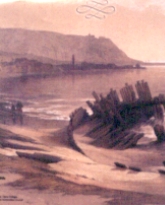Introduction to Marine Archaeology in Israel
Introduction to marine archaeology in Israel

Lithography by D. Roberts c. 1839, view facing M. Carmel
The southern Levantine coasts have been a nursery for maritime civilizations since the Pre- Pottery Neolithic period. These coasts are the closest marine environments to the core areas in which plants and animals were first domesticated.
The first agro-pastoral-marine subsistence systems (so called "Mediterranean fishing villages") emerged on these coasts during the 9th millennium BP. During historical periods the Israeli coast had been a crossroad and a busy trading route of many civilizations. Thousands of years of commerce, fishing, seafaring and naval warfare, have left an abundance of archaeological remains and artifacts on the coasts and sea beds of the Mediterranean, the Sea of Galilee, the Dead Sea and the Red Sea.
The finds include shipwrecks and cargoes, ports and anchorage sites, submerged prehistoric settlements and rock-cut coastal installations. Thus the underwater archaeological heritage of the Land of Israel represents an important chapter in the history of humanity, and is associated with the beginning of agriculture and the
emergence of the three major monotheistic religions.
The marine archaeological sites on the Mediterranean coast of Israel were classified according to their function, location in the coastal zone and risks. In addition, the coastal regions were classified according to the concentration and importance of the antiquities.
The archaeological evidence obtained from the submerged sites enabled the reconstruction of palaeoenvironments and Holocene sea levels in the Carmel Coast. They also provide valuable information concerning the material cultures, economy and subsistence of coastal entities in the southern Levant during the Neolithic period.
History of marine archaeology in Israel
Underwater archaeological research in Israel began in the early 1960’s. During that time the ‘Association for Underwater Research in Israel’ (AURI) was established. In 1972 the Center for Maritime Studies (CMS) and the Department of Maritime Civilizations were established at the University of Haifa (the CMS later became the Recanati Institute for Maritime Studies - RIMS). The Marine inspection unit of the Department of Antiquities began its activities in 1978. In 1990, the unit started operating from its base at Kibbutz Neve-Yam as the Marine Archaeology Branch (MAU) of the Israel Antiquities Authority (IAA).
Intensive archaeological activities which have been carried out in 40 years of research have yielded valuable information about the material culture, seafaring, fishing methods and economy of ancient populations of the southern Levantine coasts. Thus, underwater archaeology adds a new dimension to the research of ancient cultures in the Holy Land.
The Association for Underwater Research in Israel (AURI)

Excavation of the Sharm el Sheikh wreck
The association was established in 1961 by: E. Linder, A. Raban, J. Galili and J. Shapira. It was the first organization for underwater archaeology in Israel. The AURI members, who were volunteer divers, carried out operations from the main center at Caesarea and the Maritime Museum in Haifa. The AURI was engaged in excavations at: Caesarea harbor, Acre harbor, Atlit harbor and Shave-Zion and Philadelphia shipwrecks. Surveys were carried out off the Western- Galilee coasts, the Carmel coast (from Haifa to Caesarea), Apollonia, Ashqelon and the eastern coast of Sinai. Excavations were also carried out off the Red Sea coasts, including ‘Coral Island’, ‘Sharm El Sheik shipwreck’, the ‘Mercury shipwreck’ and ‘Na'amah shipwreck’ north of Sharm El Sheikh. In 1978 the finds from the Sinai coasts were returned to the Egyptian Department of Antiquities after the peace agreement.
Institutions and Organizations
The Leon Recanati Institute for Maritime Studies (RIMS, former CMS) at Haifa University
The CMS was inaugurated in 1972. It conducts and promotes research projects that encompass human activities relating to the sea. By combining history, archaeology, earth sciences and marine resources, the institute bridges between humanities, sciences and technology. Students participate in the ongoing research carried out at the institute as part of their training, and most of them write theses with the support of the technical staff of the institute. The institute maintains a marine workshop for professional diving and marine surveying.
The selected subjects of ongoing research at the institute are: Caesarea land and sea excavations, the Tel Nami land and sea regional project, the Ma'agan Michael shipwreck project, and the Tantura (Dor) lagoon excavations.
The Department of Maritime Civilizations at the University of Haifa
The department was established in 1973. It conducts an interdisciplinary graduate program, focusing on the interaction between man and the sea. Courses relating to the fields of marine and coastal archaeology, maritime history, marine and coastal geomorphology, geology, and marine biology and ecology are available. Graduates are awarded MA and PhD degrees.
Classification of Underwater Archaeological Sites
Submerged prehistoric settlements
1. Settlement: structures, installations, burials, tools.
2. Seasonal settlement: installations, tools.
3. Concentration of ancient remnants.
Coastal settlements
1. Coastal town: structures and installations on the coastline and in the sea.
2. Coastal settlement: village, fortress, structures, installations.
3. Concentration of ancient remnants.
Shipwrecks
1. Remains of wooden hull and cargo.
2. Concentration of cargo and remnants of vessel lacking wooden sections of the hull.
3. Concentration of ballast stones.
4. Single find that originated from a ship.
Ports and Anchorages
1. Built-up port: docks, quays and breakwaters.
2. Anchorage: natural formation improved by man.
3. Natural anchorage: temporary shelter ships in a bay or a natural feature.
4. Anchorage in open sea: concentration of anchors off shore.
Rock-cut installations on the coastline
1. Quarries.
2. Pools.
3. Slipways
4. Channels.
5. Installations for producing salt.
6. Rock-cut bollards and mooring facilities